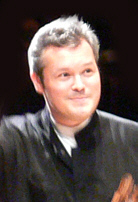
Yehudi Menuhin, Baron Menuhin, was an American-born violinist and conductor who spent most of his performing career in Britain. He is widely considered one of the greatest violinists of the 20th century.
Elaine Shaffer was an American flutist and principal of the Houston Symphony Orchestra between 1948 and 1953.
The Grammy Award for Best Classical Performance - Instrumental Soloist or Soloists was awarded from 1967 to 1971 and in 1987. Outside of these years the award has been divided into the Grammy Award for Best Instrumental Soloist(s) Performance and the Grammy Award for Best Instrumental Soloist Performance.

Felix Mendelssohn's Violin Concerto in E minor, Op. 64, is his last large orchestral work. It forms an important part of the violin repertoire and is one of the most popular and most frequently performed violin concertos in history. A typical performance lasts just under half an hour.

Edward Elgar's Cello Concerto in E minor, Op. 85, his last notable work, is a cornerstone of the solo cello repertoire. Elgar composed it in the aftermath of the First World War, when his music had already gone out of fashion with the concert-going public. In contrast with Elgar's earlier Violin Concerto, which is lyrical and passionate, the Cello Concerto is for the most part contemplative and elegiac.

The Double Concerto in A minor, Op. 102, by Johannes Brahms is a concerto for violin, cello and orchestra. The orchestra consists of 2 flutes, 2 oboes, 2 clarinets, 2 bassoons, 4 horns, 2 trumpets, timpani and strings.
Sinfonia concertante is an orchestral work, normally in several movements, in which there are parts of solo instruments, generally two or more, contrasting of a group of soloists with the full orchestra. It emerged as a musical form during the Classical period of Western music from the Baroque concerto grosso. Sinfonia concertante encompasses the symphony and the concerto genres, a concerto in that soloists are on prominent display, and a symphony in that the soloists are nonetheless discernibly a part of the total ensemble and not preeminent. Sinfonia concertante is the ancestor of the double and triple concerti of the Romantic period of 19th century.

Edward Elgar's Violin Concerto in B minor, Op. 61, is one of his longest orchestral compositions, and the last of his works to gain immediate popular success.
Ludwig van Beethoven's Concerto for Violin, Cello, and Piano in C major, Op. 56, more commonly known as the Triple Concerto, was composed in 1803 and later published in 1804 by Breitkopf & Härtel. The choice of the three solo instruments effectively makes this a concerto for piano trio, and it is the only concerto Beethoven ever completed for more than one solo instrument. A typical performance takes approximately thirty-seven minutes.

Vadim Viktorovich Repin is a Russian and Belgian violinist who lives in Vienna.

Julia Fischer is an acclaimed German classical violinist and pianist. She teaches at the Munich University of Music and Performing Arts and performs up to 60 times per year. On 1 January 2008, at the Alte Oper in Frankfurt, Fischer performed Camille Saint-Saëns' Violin Concerto No. 3 in B minor as the solo violinist, and Edvard Grieg's Piano Concerto in A minor as a pianist, two of the most technically demanding concertos.

Hephzibah Menuhin was an American-Australian pianist, writer, and human rights campaigner. She was sister to the violinist Yehudi Menuhin and to the pianist, painter, and poet Yaltah Menuhin. She was also a gifted linguist and writer, co-authoring several books and writing many papers with her second husband, Richard Hauser.

Robert Schumann's Violin Concerto in D minor, WoO 23 was his only violin concerto and one of his last significant compositions, and one that remained unknown to all but a very small circle for more than 80 years after it was written.

The Concerto for Violin and String Orchestra in D minor was composed by Felix Mendelssohn at the age of thirteen. It has three movements, Allegro–Andante–Allegro, and performance duration is approximately 22 minutes.
The Concerto for Two Violins and String Orchestra, Op. 77 by Malcolm Arnold was finished in 1962. It is in three movements:
- Allegro risoluto
- Andantino
- Vivace – Presto
Aisha Syed Castro is a Dominican violinist and a member of the Yehudi Menuhin School orchestra.
Edward Elgar's Violin Concerto was first recorded complete in 1929. Truncated versions had been recorded in 1916 using the acoustic recording process, the technical limitations of which necessitated drastic rearrangement of the score. Electrical recording, introduced in the 1920s, gave a greatly improved dynamic range and realism, and the two leading English record companies, Columbia and His Master's Voice (HMV) both made recordings of the concerto that remain in the catalogue. The first was made for Columbia by Albert Sammons with the New Queen's Hall Orchestra conducted by Sir Henry Wood. Elgar's own recording with the young Yehudi Menuhin followed three years later. Since then there have been more than twenty-five further recordings, featuring British and international performers.
Kirill Troussov in Saint Petersburg, is a German violinist and violin teacher based in Munich, Germany.
The Bassoon Concerto, composed by Andrzej Panufnik in 1985, is a concerto for bassoon and orchestra dedicated to Jerzy Popiełuszko, an anti-communist Polish priest who was murdered by three secret police agents in 1984. The work was commissioned by the American bassoonist Robert Thompson.












